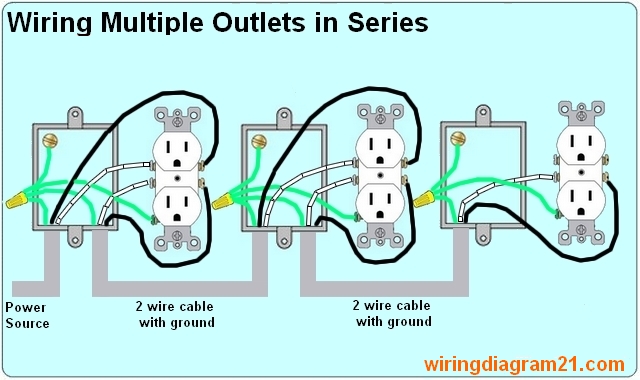Have you ever been in the middle of a home improvement project, gazing at a tangled mass of wires, and wondered, “Can I just use this 14/2 wire for my outlets?” The answer, while seemingly simple, is actually a bit more nuanced. It’s not just about connecting wires; it’s about ensuring the safety and longevity of your electrical system. This guide will delve into the world of 14/2 wire and its suitability for outlets, equipping you with the knowledge to make informed decisions about your electrical wiring.

Image: wirepartallen.z5.web.core.windows.net
14/2 wire—that ubiquitous, familiar cable used in countless homes—holds the key to powering the lights, appliances, and conveniences we rely on daily. But whether it’s the right choice for your specific outlet depends on a multitude of factors, from the amperage required by the appliance to the code requirements in your region. Let’s unravel the intricacies of choosing the right wire for the job.
Deciphering the Code: Understanding 14/2 Wire
Before embarking on any electrical work, it’s crucial to understand the basics of wire gauge and the role it plays in electrical safety. The “14” in 14/2 wire refers to its gauge—a measure of its thickness. The lower the gauge number, the thicker the wire. The “2” indicates that the cable contains two conductors—a hot wire and a neutral wire—plus a ground wire for safety.
The National Electrical Code (NEC) sets the standards for safe electrical installations. The NEC specifies the appropriate wire gauge for various applications based on the anticipated current draw. 14/2 wire is generally suitable for circuits that draw 15 amps or less.
14/2 Wire and Outlets: A Closer Look
The widespread use of 14/2 wire stems from its versatility. It’s commonly found in residential wiring for:
- Lighting Circuits: Powering light fixtures, ceiling fans, and other low-amperage lighting.
- General-Purpose Outlets: Commonly used in bedrooms, living rooms, and hallways for small appliances and electronic devices.
However, the NEC dictates restrictions on the use of 14/2 wire for outlets, particularly those intended for high-amperage devices:
- High-Amperage Appliances: Appliances demanding more than 15 amps, such as electric ranges, dryers, and water heaters, require heavier gauge wire like 12/2 or even thicker.
- Continuous Loads: Devices that run constantly, like refrigerators, require wire that can handle continuous high-current flow. 12/2 wire ensures sufficient capacity to avoid overheating and potential hazards.
Navigating the Amperage Landscape
The amperage rating of an outlet is a crucial aspect to consider when choosing the right wire. It indicates the maximum current the outlet can safely handle. 14/2 wire is typically rated for 15 amps, but it’s essential to consult the NEC for specific requirements and safety guidelines.
- Understanding Amperage: Many appliances have their amperage rating listed on their nameplates. Ensure that the wire gauge you select can handle the appliance’s maximum current draw.
- Circuit Protection: Circuit breakers are essential safety devices that protect your electrical system from overloads. They are always rated for the same amperage as the wire they protect. For example, a 15-amp circuit breaker will be used on a 14/2 wire circuit.
- Continuous Load Rule: The NEC requires derating for continuous loads, meaning the maximum amperage allowed is reduced to 80% of the circuit rating. For example, a 15-amp circuit can only safely handle a continuous load of 12 amps.

Image: schematicfixfurst.z19.web.core.windows.net
Case-by-Case Analysis: The Right Wire for Your Needs
Every electrical project is unique, and assessing the specific requirements is essential. Here’s a step-by-step guide to help you make informed decisions:
- Determine the Amperage: Identify the amperage rating of the device you plan to plug into the outlet.
- Consult the NEC: Refer to the latest NEC guidelines for recommended wire gauge for the intended circuit.
- Factor in Continuous Loads: If the appliance will run continuously, ensure the wire gauge can handle the derated amperage for continuous loads.
- Check Existing Wiring: When dealing with existing wiring, it’s wise to verify the gauge of the wire already in place. Never attempt to use thinner wire to replace existing thicker wire.
Expert Insights: Seeking Professional Guidance
Navigating the intricacies of electrical wiring can be overwhelming, especially for novices. Seeking professional guidance from a licensed electrician is strongly advised, particularly for:
- Complex Electrical Systems: Large home renovations or commercial projects require the expertise of a trained professional.
- Doubts about Compatibility: When unsure about the suitability of 14/2 wire, an electrician can provide a precise assessment and ensure safe and code-compliant installations.
- Safety First: Electrical work carries inherent risks, and engaging a qualified electrician prioritizes safety and minimizes potential hazards.
Can I Use 14/2 Wire For Outlets
Conclusion
When it comes to electrical wiring, safety should always be paramount. While 14/2 wire is a versatile and reliable choice for many outlets, understanding its limitations and consulting the NEC is crucial. The right wire gauge depends on the specific application and amperage requirements. By carefully assessing the electrical needs of each project and consulting a qualified electrician whenever necessary, you can ensure that your electrical system is safe, efficient, and ready to power your life.
With this knowledge, you can navigate the world of electrical wiring with greater confidence, ensuring that your home is a safe and comfortable environment for you and your family.

:max_bytes(150000):strip_icc()/OrangeGloEverydayHardwoodFloorCleaner22oz-5a95a4dd04d1cf0037cbd59c.jpeg?w=740&resize=740,414&ssl=1)




